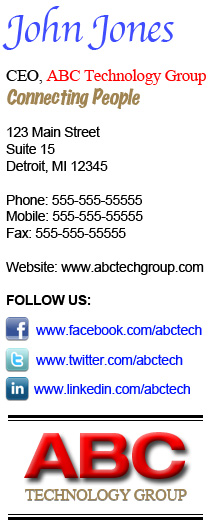Business Toolbox: How to Standardize Your E-mail Signature
November 2010
By The Developer

E-mail is the workhorse of communication for your business. It’s likely to be your first point of personal contact with prospective customers as well as your go-to vehicle for conducting day-to-day conversations with existing clients.
As a result, your e-mail signature is an important – but all too often overlooked – extension of your brand. Just as you wouldn’t mail a letter or a proposal printed on any old paper stock, you should give equal consideration to creating and implementing a standardized corporate e-mail signature.
However, this is where things get a little tricky. While your e-mail signature serves as your electronic business card, it doesn’t play by the same rules of branding that govern your stationery, website design or even participation in social media networks.
Here are five common misconceptions that can lead you astray when crafting your signature:
1. If I’m going to represent my brand, I must include my logo.
According to conventional thinking, your company’s brand and logo are one and the same. However, as counterintuitive as it might seem, it is best not to include your logo in your e-mail signature.
Why? Because it is difficult to control how images are interpreted and displayed by different e-mail clients. Most e-mail applications either store images as attachments or block them, resulting in a broken image. Therefore, if you construct your signature around a logo, and that image frequently is not displayed, it compromises the consistency and professionalism that you are trying to achieve.
The best, most universally replicable alternative is to integrate your corporate colors in your signature, albeit with restraint. For example, you might choose to display your company name in one of your corporate colors, which will make it the most prominent element while also employing one of the primary elements of your visual brand.
2. Personality, personality, personality...it’s all about personality, right?
In marketing, yes. On Facebook, Twitter and LinkedIn, you’ll never get anywhere without personality. However, when it comes to e-mail, make sure your messages are friendly and personable, but keep your signature strictly professional.
The one and only purpose of an e-mail signature is to let the recipient know who sent the message and provide a way for them to get in touch with you.
You might think it’s fun to include your favorite quotation in every e-mail, but in doing so, you run the risk of unknowingly offending a client or prospect.
And never include any non-company-related information in your corporate e-mail signature. Not a link to your personal blog, not the URL of your side-project website, not your Facebook, Twitter or Skype details. That’s only asking for trouble.
3. It’s important to make a lasting impression.
The only impression you want your e-mail signature to make is professionalism. If your clients remember your signature and not the point of your message, there’s a problem.
Don’t give into the temptation to experiment with large, bold or multi-colored text. Don’t try to use the typeface from your logo; more often than not, it won’t be displayed properly by the recipient’s e-mail client. Stick with simple, plain, web-safe fonts in the same size as the body of your message, and you can’t go wrong.
Returning to the example of mailing a letter or a proposal, there’s a reason you would never print your correspondence on multi-colored florescent paper. Like your letterhead, your signature should reflect the legitimacy and gravity of your business-related communication. It should never compete with your message or in any way distract from the information you need to convey.
4. I need to make sure that my clients can reach me by any and every means necessary.
There’s no question that great customer service is a key competitive edge in today’s marketplace. And it’s understandable why giving your clients your direct office line, 800 number, cell phone, fax number, IM handle, mailing address and LinkedIn profile would seem to convey that you are accessible at their convenience through any number of channels.
However, a much better way to serve your clients is to provide the one method of contact through which they can almost always reach you. Most of the time, this will be a phone number (pick one: work or mobile). Then, rather than having to sift through a dozen different means of communication to identify the one they need or play guessing games about which one will connect them to you in the most expedient manner, it will be right there for them to find at a glance.
As a rule, there’s no need to include your fax number or your mailing address in your e-mail signature. In the unlikely event that your client needs to send you something by fax or mail, you can either include this information in the body of your message, or they can jump over to your website, where these details should always be readily available.
5. I want to drive traffic to my blog / encourage people to follow me on Twitter / promote a limited-time offer.
These are all great marketing objectives. However, you must always keep in mind that e-mail is, first and foremost, a platform for communication between one human being and another.
You wouldn’t wrap up a phone conversation with your client by asking them to be your friend on Facebook, and you wouldn’t conclude a sales meeting by making a blatant plug for your blog. Your e-mails aren’t billboards for your marketing message du jour; always keep it personal and professional.
Including your website URL in your signature is a good way to indirectly promote your business, its presence on various social media networks and targeted marketing efforts without cluttering up your e-mail messages. If your customer or prospect clicks through to your site, they should be presented with all of these options – most likely before they ever leave the cover page.
Best practices for a professional e-mail signature
Follow these tried-and-true guidelines to ensure your e-mail signature is polished, professional and customer-friendly:
- Focus on providing only the most essential information about who you are and how you can be reached in an effective and unobtrusive way.
- Limit your signature to four lines (the accepted standard), with a maximum of 72 characters per line to optimize how it is displayed in different e-mail applications. Combine different types of information on one line by using pipes (|) to separate the text.
- Typically, you should include only your name, job title, company, primary method of contact and corporate web address. Don't repeat your e-mail address in your signature.
- Write out the URL for your company website rather than using hyperlinked text.
- Create different signatures for different purposes. For example, you might have one version for e-mails you send to vendors that includes your office line and another for client correspondence that provides your cell number.
- Always add a signature to replies, but include fewer details. For example, whereas your primary e-mail signature would most likely include your name, position, company name, contact information and web address, your reply signature might provide only your name, primary form of contact and web URL.
- Don’t include a legal disclaimer unless required to do so. The best practice is not to transmit confidential information in plain text in e-mails because that information could easily be extracted or forwarded.
- Use a signature delimiter to create visual separation between your signature and the body of your e-mail. The standard protocol recognized by most e-mail clients is two hyphens followed by a space and a line break (-- ).
- Don't use HTML formatting, as it can interfere with how your signature is displayed in some e-mail clients.
- Simple, plain text in the same size as the body of your e-mail is best. Employ bold or colored text very sparingly for emphasis, and use only your corporate colors.
- Don't use an image as your signature, and avoid including images in your signature.
- Be sure to test your signature in as many different e-mail clients as you can (including web-based applications like Gmail). Don't forget to also check how your signature looks when forwarded to ensure that all lines wrap correctly.
Do this:
--
John Jones
CEO, ABC Technology Group
555-555-5555
http://www.abctechgroup.com
Don’t do this:

Fame Foundry's front-end developer has been designing and crafting website experiences for national corporations and small companies that have consistently delivered customers to clients.